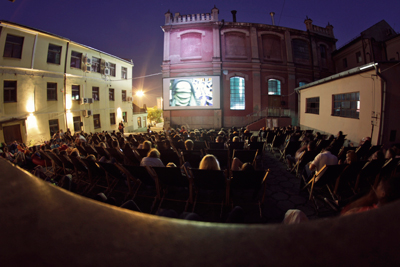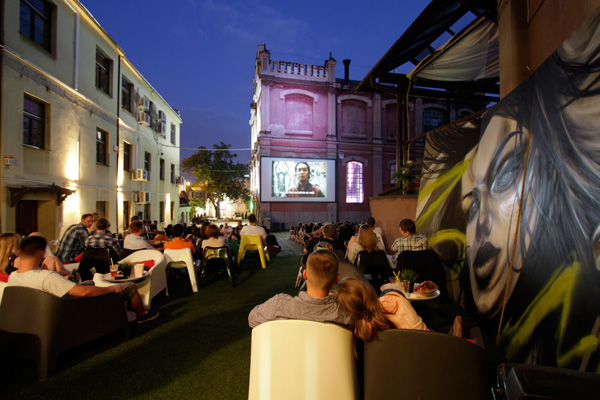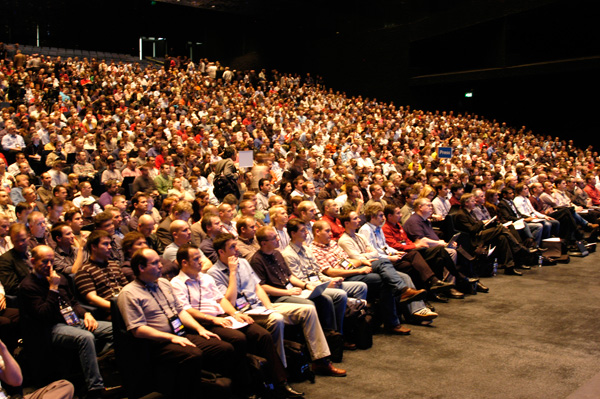Part 3 of How to Make Money in the Age of Abundance
By Jon Reiss
Theatrical is Dead Long Live Theatrical. The holy grail of a theatrical release still rings as a delusion for many. Fighting words still for untold thousands of filmmakers. Who doesn’t want their name in lights – long lines around the block – a packed theater of adoring fans. I believe this live engagement with fans is crucial for artists. But traditional theatrical is probably not the way you are going to do it.
In the first post in this series, I indicated that filmmakers need to create scarce resources in order to compete with the abundance of digital. Today’s post will focus on events – or what I have termed Live Event/Theatrical. The essence of this renaming is for filmmakers to reformulate and to reclaim what the industry calls theatrical – for more on that see Think Outside the Box Office. (PS – I first said this was a two part series – then I said three parts – well I lied again and now it will be four parts – with Part 4 tomorrow).

When films were only available in a movie theater – that was a scarce resource that could be charged for – it was the only way to see films. As technology developed new ways to see films, content creators/studios created release windows to control the monetization process of their film products attempting to keep the theatrical release as providing the highest per viewer fee per view fee.
But besides competition from other platforms, a traditional theatrical release is not a scarce resource: multiple screenings per day in multiple theaters with no end date is essentially an infinite supply. The release window is still the only way that traditional distributors create artificially scarcity and for most films this is not enough for audiences to sacrifice any of their other myriad of entertainment options. Unless you have created a rabid fan base who has to see the film at its first opportunity – which happens for a few films, but not many – traditional theatrical does not offer the consumer anything unique. Quite the contrary:
Traditional theatrical gives consumers an excuse not to see a film when the filmmaker wants their audience to engage with it. Why spend the time, effort (which are often more valuable than the $12 ticket price) to see something that will be available much cheaper and more conveniently soon enough?
Creating scarcity is an independent filmmaker’s way of creating demand for their Live Event/Theatrical “products”. The essence of scarcity is: people want what they fear they might not be able to have. Scarcity also creates something will be unique to them and a few others. The scarcer something is, the more demand you can create for it. Simply put: by decreasing supply with stable demand you increase value.
The essential consumer value of Live Event/Theatrical must be a live communal experience, unavailable anywhere else. I will write about the importance of community and the extra value that this creates to screenings at another time. It is important to keep in mind that this post is not just about monetizing through events – but is about creating ways to keep that important experience of watching films communally with other people – especially strangers. Hence the event creates something new – never created before and even beyond the elements that you provide. This communal added value experience is quite different than the consumer value of Digital Products, which is one of convenience. Live Event Theatrical can never compete with digital on the level of convenience and must create its own value to succeed.
How to Create Unique Live Experiences Unavailable Anywhere Else (AKA scarcity for Live Event/Theatrical:
1. Time Scarcity: Embrace the One Night Screening – All things being equal, for small films with limited budgets, one night screenings are much easier to book and will in general be more successful in terms of audience and money. By only offering a communal experience once in a particular geographical location, is an immediate way to make it scarce (only that number of seats are available) and immediately more. The more you promote sales of tickets being sold, the more urgency you can create for the event. When you sell out you can add more screenings “by popular demand”, creating demand where perhaps none existed before.
I have experienced this over and over again for my own films and my clients’ films. For our recent US premiere of Bomb It 2 in Miami, the film sold out several days before the event.
One of the benefits of Live Event/Theatrical for filmmakers is publicity and awareness (events by their nature do this) – but the more you add value and uniqueness to an event – the more it will create awareness. (As a caveat – four years ago it was hard to get the press to cover one night film screenings – but now that is changing more and more – and especially if you as the filmmaker add uniqueness to the event).
2. Time Scarcity – Part 2 National and/or International One Night Screenings.
This takes time, effort, coordination but can be extremely successful. Going through satellite service providers such as Fathom, Screenvision and Cinedigm can be expensive (although the latter has started releasing films that they acquire in this manner). But savvy filmmakers can do this without the traditional $75,000-$125,000 satellite fee.
Two notable cases are The Age of Stupid from Franny Armstrong and Lizzie Gillet of Spanner Films (who used Fathom in the US), which still has the record for number of screenings (500) and number of countries (40) for an independent film in a 2 day period. (Can anyone beat this?) For Joffrey: Mavericks of American Dance Sheri Candler and I worked with Ira Deutchman and his Emerging Pictures to create a 45 city one day event which was also the world premiere screening of the film. The total cost of this was $1000 (Emerging’s Fee), which we was deducted from the box office. In both of these cases the filmmakers added unique elements besides the limited time to further enhance the event.
3. Create Unique Live Qualities Unavailable Anywhere Else – Topical Celebrities
For the Joffrey film we netcast a q&a with Joffrey Ballet alumni which our research indicated was what our audience valued the most for live events (not live ballet that I had originally thought). We also enabled audience from around the country to participate in the Q&A via Twitter. Video documentation here. For Age of Stupid Franny and Lizzie had a numerous celebrities participate both live and via Skype.
For the Connected New York theatrical Tiffany Shlain arranged a different notable guest speaker for every screening turning each one into a unique event and selling out nearly all of her screenings in the process.
4. Create Unique Live Qualities Unavailable Anywhere Else – Live Music
Examples abound from Anvil: Story of Anvil, DJ Spooky, Braden King’s Here, Corey Mcabee whose own band The Billy Nayer Show plays live with his films and again Ride the Divide who still take the cake by selecting bands for their soundtrack proactively who would perform in the cities they knew were geographical targets for their audience.

5. Create Unique Live Qualities Unavailable Anywhere Else – Live Music Remix.
I am finally putting my money where my mouth is – our Austin premiere at the Alamo Drafthouse for Bomb It 2 with be remixed live by DJ Chorizo Funk. To do this I created a D&E (dialogue and effects) mix of the film on a separate screener – and then provided all the tracks to the DJ and theater on a separate CD/download. Other event attributes of this screening: live graffiti painting in front of the theater before the event, local featured artist Sloke appearing after the screening (note the importance of using a local artist with his own audience base) and skype Q&A by yours truly (although this may convert into a pre-recorded pre-screening intro). I also timed this event to coincide with the conclusion of the Bomb It 2 Kickstarter campaign to have a special event to cap off our fundraising.
6. Create Unique Live Qualities Unavailable Anywhere Else – Live Film Editing
A difficult undertaking, and only for particular films and filmmakers – but check out what Peter Greenaway did for Tulse Luper Suitcases. He had a customized VJ board created and reedited the film live for select event screenings like this one in Krakow, Poland. A technological update to this is Mark Harris’s The Lost Children which based on audience reaction “alters itself, hiding and revealing different aspects with each screening.”
7. Create Unique Live Qualities Unavailable Anywhere Else – Audience Participation.
Rocky Horror Picture show is the most famous example, but indies such as Best Worst Movie have had their fans dressing up and participating as well. Corey McAbee recounted that in Melbourne Australia people would dress up as the characters in American Astronaut and sing along – for years of midnight screenings.
8. Create Unique Live Qualities Unavailable Anywhere Else – Actors Performing With the Film, Text Messaging, Immersive Experiences.
Each of these techniques can be done separately, but so far the filmmakers experimenting with this such as Lance Weiler with Head Trauma and more recently Mark Harris with The Lost Children are combining multiple aspects to create immersive experiences for their audiences.
9. Beyond Live Event Theatrical: Experiences
This needs its own blog post – but again crowdfunding has pushed filmmakers to think expansively about creating unique scarce experiences that can be offered to fans such as dinners, set experiences, live chats, backstage access etc. What you offer depends on your audience. Since my audience is mostly comprised of independent filmmakers, for my Kickstarter I have offered a variety of experiences that are based on my consulting brand: a monthly group conference call/presentation with twitter q&a, one time conversations, monthly workshops and individual intensive consultations. What value can you provide to your audience? What does your audience want from you?

10. Creating Unique Live Events – What Am I Missing?
I would love to get examples from you as to what unique screenings and events you have created or experienced?
On Tuesday I will conclude this series with a look at creating scarcity with merchandise. I am currently running a Kickstarter campaign, so you can see how I am utilizing scarcity, membership, and digital exclusivity to raise funds for my latest film, Bomb It 2, here: bombit2Kickstarter.com http://www.bombit2kickstarter.com
We have met our goal – but have added a stretch goal of $20K to help cover all of our expenses. More important than the stretch goal, though, is our goal to create a community of 300 backers for BOMB IT 2. As of this moment, as I am writing this for you, I have 280 dedicated backers who have not only pledged money but most of whom has dedicated time and effort toward spreading the word about the campaign. Yes, I’ll give them the movie and other perks, such as consultations, posters, original art, etc. in exchange for their contribution, but they’re giving me much more.
Please check it out, contribute if you’re moved, and – no matter what – stay tuned for the final part of this series on “How to Make Money in a Time of Abundance.”
Jon Reiss is filmmaker (Bomb It, Better Living Through Circuitry), author (Think Outside the Box Office) and media strategist who works with filmmakers, companies and organizations to help them utilize the most recent techniques of direct film distribution and audience engagement.





